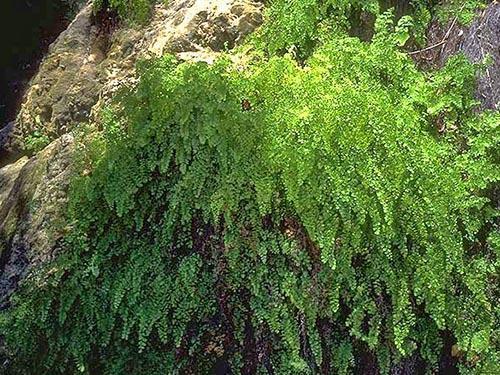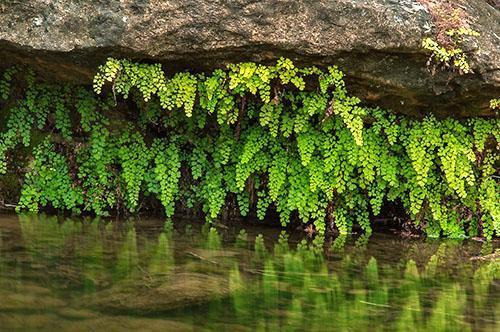Photos and descriptions of individual types of maidenhair
 Representatives of the maidenhair genus inhabiting many regions of the world are perennial herbaceous ferns. Several species with openwork bright green foliage are used as indoor plants, which are rightfully considered the main advantage and distinctive feature of the genus. Indoor adiantums are undemanding and do not lose their decorative effect with regular care for many years. See photo of a tulip tree!
Representatives of the maidenhair genus inhabiting many regions of the world are perennial herbaceous ferns. Several species with openwork bright green foliage are used as indoor plants, which are rightfully considered the main advantage and distinctive feature of the genus. Indoor adiantums are undemanding and do not lose their decorative effect with regular care for many years. See photo of a tulip tree!
Maidenhair Venus hair (A. capillus-veneris)

The plant height is slightly more than half a meter. The leaves are feathery, asymmetrical, and can grow up to 20-25 centimeters long. Individual segments, which are obovate, do not exceed 2–3 cm in length. The upper part of the segments is notched and often fan-shaped. The light leaf plates contrast with the dark, almost black petioles that give the plant its name.
 In nature, Venus hair prefers to inhabit the rocky shores of streams, mountain rivers and other bodies of water. At the same time, on small accumulations of soil between stones, a powerful rhizome less than a meter long helps the plant to anchor. Many thin auxiliary roots cling to rocky ledges, so you can see the maidenhair of this species, as in the photo, on steep slopes.
In nature, Venus hair prefers to inhabit the rocky shores of streams, mountain rivers and other bodies of water. At the same time, on small accumulations of soil between stones, a powerful rhizome less than a meter long helps the plant to anchor. Many thin auxiliary roots cling to rocky ledges, so you can see the maidenhair of this species, as in the photo, on steep slopes.
Ripening of spores located along the edge of leaf segments takes place from late spring to autumn. At home, slowly growing ferns are often propagated vegetatively.
Large-leaved maidenhair (A. Macrophyllum)
 The large-leaved maidenhair shown in the photo is a perennial fern with a height of 30 to 50 cm.In nature, the species occurs in the tropical zone of Central and South America. A fern with a beautiful rosette of large leaves of a characteristic shape can be found along roads, under bridges and near drains.
The large-leaved maidenhair shown in the photo is a perennial fern with a height of 30 to 50 cm.In nature, the species occurs in the tropical zone of Central and South America. A fern with a beautiful rosette of large leaves of a characteristic shape can be found along roads, under bridges and near drains.
 You can recognize the presented maidenhair by the pointed segments of the leaves, along the cut of which the spore maturation zones are located. In addition, the young foliage of the maidenhair has an unusual pinkish coloration, and only the mature leaves turn light green.
You can recognize the presented maidenhair by the pointed segments of the leaves, along the cut of which the spore maturation zones are located. In addition, the young foliage of the maidenhair has an unusual pinkish coloration, and only the mature leaves turn light green.
Maidenhair foot (A. pedatum)
 One of the types of ferns with high frost resistance, which allows you to grow maidenhair stop-like in gardens in the south and in the center of Russia. The leaves of this maidenhair species are flat, bright green, with dark thin shafts. The height of an adult fern reaches 0.6 meters, and the bush keeps an attractive hemispherical domed shape well. Leaf segments are notched along one edge, where the spore accumulation zones are located.
One of the types of ferns with high frost resistance, which allows you to grow maidenhair stop-like in gardens in the south and in the center of Russia. The leaves of this maidenhair species are flat, bright green, with dark thin shafts. The height of an adult fern reaches 0.6 meters, and the bush keeps an attractive hemispherical domed shape well. Leaf segments are notched along one edge, where the spore accumulation zones are located.
 Under natural conditions and in a potted culture, a fern of this species grows slowly, but it is loved by flower growers for its high decorative effect and unpretentiousness. The main condition for the successful cultivation of this type of maidenhair is loose soil, the presence of shade and competent watering.
Under natural conditions and in a potted culture, a fern of this species grows slowly, but it is loved by flower growers for its high decorative effect and unpretentiousness. The main condition for the successful cultivation of this type of maidenhair is loose soil, the presence of shade and competent watering.
One of the interesting varieties of this fern is considered to be the maidenhair stop-shaped subspecies aleuticum.
 According to the description and photo of the maidenhair, the view is distinguished by its graceful shape and growth of about 30 centimeters. The width of an adult plant is slightly larger. The fern stays on the ground thanks to its thick surface rhizome.The fronds of a dim green color are located on black-brown rods. Leaves are double-pinnate, symmetrical. Some leaf lobes have one excised edge with rounded or obtuse teeth.
According to the description and photo of the maidenhair, the view is distinguished by its graceful shape and growth of about 30 centimeters. The width of an adult plant is slightly larger. The fern stays on the ground thanks to its thick surface rhizome.The fronds of a dim green color are located on black-brown rods. Leaves are double-pinnate, symmetrical. Some leaf lobes have one excised edge with rounded or obtuse teeth.
Adiantum venustum (A. venustum)
 In Nepal and the Indian state of Kashmir, you can see another type of maidenhair with obovate, somewhat elongated leaf segments, dark, purple-brown petioles and a height of about 40 cm.
In Nepal and the Indian state of Kashmir, you can see another type of maidenhair with obovate, somewhat elongated leaf segments, dark, purple-brown petioles and a height of about 40 cm.
The view of the maidenhair, as in the photo, has a high decorative effect and can serve both for interior decoration and for creating a unique atmosphere in the garden. The plant is also applicable for vertical gardening. High frost resistance allows growing ferns in the south of Russia in the open field.
Maidenhair reniform (A. reniforme)
 Florists who are just beginning to get acquainted with the types of maidenhair, looking at the maidenhair maidenhair, often do not believe that a plant with horseshoe-shaped leaves on long petioles is a fern. Indeed, a surprisingly modest, but full of grace plant does not look like the famous maidenhair Venus hair or another species, whose photo and description are given above.
Florists who are just beginning to get acquainted with the types of maidenhair, looking at the maidenhair maidenhair, often do not believe that a plant with horseshoe-shaped leaves on long petioles is a fern. Indeed, a surprisingly modest, but full of grace plant does not look like the famous maidenhair Venus hair or another species, whose photo and description are given above.
Found wild in the Canary Islands, the maidenhair is reniform, depending on the variety, reaches a height of 5–30 cm. There are two subspecies of this plant.
 According to the photo and description, maidenhair reniforme is a larger fern with leaves up to seven centimeters in diameter and 20 centimeters high petioles. And the pusillum subspecies is two times smaller.
According to the photo and description, maidenhair reniforme is a larger fern with leaves up to seven centimeters in diameter and 20 centimeters high petioles. And the pusillum subspecies is two times smaller.
Moreover, the habitat of these plants is similar. Ferns are found in partial shade on moist rocky ledges under trees or on steep slopes along the sea.
Adiantum Ruddy (A. raddianum)
 In the wild, the maidenhair of this species can be seen in South America. The creeping leaves of Ruddy's maidenhair are distinguished by wedge-shaped segments decorated with a rounded edge. Leaf lobes no more than a centimeter long. The leaves themselves are large, up to 45 cm in length. The petioles are thin, drooping, brown or almost black, like in other varieties of maidenhair.
In the wild, the maidenhair of this species can be seen in South America. The creeping leaves of Ruddy's maidenhair are distinguished by wedge-shaped segments decorated with a rounded edge. Leaf lobes no more than a centimeter long. The leaves themselves are large, up to 45 cm in length. The petioles are thin, drooping, brown or almost black, like in other varieties of maidenhair.
 Today at the disposal of amateurs indoor ferns there are several varieties of Ruddy's maidenhair with a unique shape and color of foliage.
Today at the disposal of amateurs indoor ferns there are several varieties of Ruddy's maidenhair with a unique shape and color of foliage.
Adiantum Ruddy Fragrants (A. raddianum Fragrantissimum)
 A fast growing and very attractive variety of the Ruddy fern forms a crown up to half a meter high. The maidenhair fragrance is distinguished by the curly shape of leaf segments and their lower density on black-gray or brown petioles.
A fast growing and very attractive variety of the Ruddy fern forms a crown up to half a meter high. The maidenhair fragrance is distinguished by the curly shape of leaf segments and their lower density on black-gray or brown petioles.
Chilean maidenhair (A. Chilense)
Chilean maidenhair was named after the country of origin. In nature, the plant reaches a size of 30–40 cm.
At home, the view of the maidenhair shown in the photo can be found at an altitude of 2000 meters. The fern feels equally well in the valleys and on the slopes of the mountains covered with deciduous forests.
 The Chilean maidenhair perfectly tolerates the climatic conditions of the humid forest, where the intervals between the rainy seasons are no more than a month. This fern species also grows in relatively dry areas, in which drought can last up to five months.
The Chilean maidenhair perfectly tolerates the climatic conditions of the humid forest, where the intervals between the rainy seasons are no more than a month. This fern species also grows in relatively dry areas, in which drought can last up to five months.
Ethiopian maidenhair (A. aethiopicum)
Despite the name, the maidenhair shown in the photo can be seen in nature not only on the African coast, but in Australia and New Zealand.
 Leaf petioles are black at the bottom. Towards the top of the leaf, they change color to brownish-purple. The segments are wide, wedge-shaped with a solid, almost rounded edge. Light green color. The total height of the fern reaches 50 centimeters.
Leaf petioles are black at the bottom. Towards the top of the leaf, they change color to brownish-purple. The segments are wide, wedge-shaped with a solid, almost rounded edge. Light green color. The total height of the fern reaches 50 centimeters.